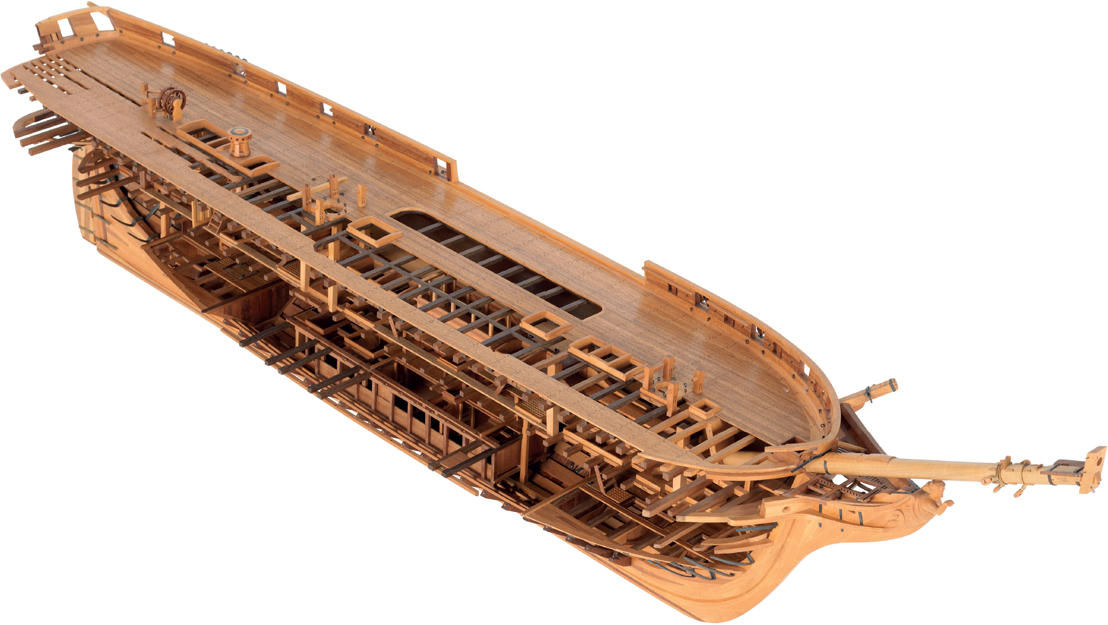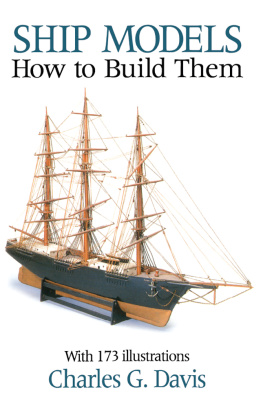
SRL0004 Bow of the Mordaunt, an ex-privateer bought into the Navy in 1683; typical of the small two-deckers that carried out cruiser duties in the Restoration period.

ZBAO430 A cutaway model of the frigate Pique of 1834. See .
Copyright Robert Gardiner 2012
First published in Great Britain in 2012 by
Seaforth Publishing
An imprint of Pen & Sword Books Ltd
47 Church Street, Barnsley
S Yorkshire S70 2AS
www.seaforthpublishing.com
Email
British Library Cataloguing in Publication Data
A CIP data record for this book is available from the British Library
ISBN: 978 1 84832 160 1
PDF ISBN: 978 1 78346 602 3
EPUB ISBN: 978 1 78383 068 8
PRC ISBN: 978 1 78346 835 5
All rights reserved. No part of this publication may be reproduced or transmitted in any form or by any means,
electronic or mechanical, including photocopying, recording, or any information storage and retrieval system,
without prior permission in writing of both the copyright owner and the above publisher.
The right of Robert Gardiner to be identified as the author of this work has been asserted in accordance with
the Copyright, Designs and Patents Act 1988
Typeset and designed by Stephen Dent
Printed and bound in China through Printworks International Ltd
Acknowledgements
Doug McCarthy and Emma Lefley of the National Maritime Museums Picture Library handled the large and complex photo orders for this book with efficiency and courtesy, while Josh Akin made a great job of the demanding scanning requirements.
On the curatorial front, the author is grateful to Simon Stephens for access to models in the Museums store, while Jeremy Michell and Andrew Choong of the Brass Foundry were very helpful with background research on the Admiralty Collection of draughts.
Finally, we must thank Major Grant Walker for permission to reproduce photographs of models in the US Naval Academy Museum that have no parallel in any other collection.
References
Footnotes have been avoided in this book, but for readers interested in pursuing the subject in more detail, there is a file of additional information, sources for quotations and the like, available on the Seaforth Publishing website at: http://www.pen-and-sword.co.uk/The-Sailing-Frigate/p/3699/
Further details of all the National Maritime Museums ship models can be found on their Collections website at: http://collections.rmg.co.uk/collections.html#!csearch;collectionReference=subject-90254;authority=subject-90254
Searching by the SLR number quoted in the captions to this book will turn up a description of the model and any available photographs.
Contents
: Prehistory
1600-1689
O ver the centuries the term frigate has carried a myriad of meanings, more often vague and suggestive rather than denoting a specific ship-type. The word itself is of Mediterranean provenance, and it is a reasonable assumption that the first vessels in northern Europe to be so described had the same origins: certainly, the first documented examples are privateers that operated out of the Spanish-held areas of the Netherlands as early as the 1590s. These were small, fast and lightly armed, characteristics that were to remain a common denominator of just about any ship called a frigate whenever and wherever the description was applied.
To track the long and convoluted history of the term is more relevant to the lexicographer than the naval historian, and the aim of this book is to follow the evolution of a concept a specialist cruising warship, not intended to fight in the line of battle but powerful enough for independent action in virtually every other naval role, in all weathers and on any ocean. These would encompass reconnaissance and other fleet support functions, both the attack and defence of trade, blockade and inshore operations, patrolling sea-lanes and suppressing piracy and smuggling. By the Nelson era the frigate had become the navys maid-of-all-work, the most flexible and broadly useful ship-type in the fleet and (with the exception of small craft) the most numerous category on the navy list.

SLR0368 On the basis of its decorative scheme this model is usually dated to just after 1660. The Shearnes is painted on the upper counter, but there is no warship of that name, nor any built at Sheerness, that would fit. However, the model has the layout, proportions and, at 1/48th scale, roughly the dimensions of the first Parliamentary frigates, with the long heavily raked stem that was a feature of the time. The model carries a small poop and royalist decorations, but, like the full-size prototype, a model could be modified in the course of its life and in 1660 republican symbolism was being removed throughout the country, from pub signs to warship names, to demonstrate loyalty to the newly restored King Charles II.
Note: The SLR number is the Museums unique object reference. As most of the models have no names, it has been used throughout this book for unambiguous identification. For the few models from Annapolis, the HHR number performs the same function.
It was not always so. In order to fulfil all these functions the frigate needed speed, seakeeping, manoeuvrability, structural strength, firepower and a large capacity (in order to stow sufficient provisions for long cruising range). This was a demanding set of requirements, many of which could only be realised at the expense of others, and all trumped by the overriding need to hold down the size and hence cost of individual ships, to maximise the numbers that could be built and manned. All naval architecture involves compromise, but the large number of variables in frigate design offered a particular challenge, leading to greater variety and more radical evolution than exhibited by the battleships of the same period.
This book charts the complex and sometimes wayward search for a perfect sailing cruiser through the medium of ship models from the incomparable collection of the National Maritime Museum at Greenwich. Because they are three-dimensional objects, models make it easier to see exactly what these ships looked like, and the best of them incorporate significant detail that is absent from plans and impossible to discern in most drawings and paintings.
F rigates first came to the attention of the English, painfully, during the 1625-30 war with Spain when the Channel was said to be infested with swiftsailing privateers from the Flemish ports under Spanish control. During this period it was estimated that they captured over 300 ships, perhaps one-fifth of the English merchant marine of that time. The kings navy, a traditional battlefleet of powerful but unhandy ships, was ill equipped to deal with the menace, and never produced an effective counter. The most concerted effort was a numbered class of ten sail-and-oar pinnaces measuring between 160 and 180 tons called generically the Lions Whelps. They racked up some initial successes, but their performance deteriorated over time, probably because of the addition of heavier superstructure and more guns the first example of a recurring theme in English cruiser design.

















